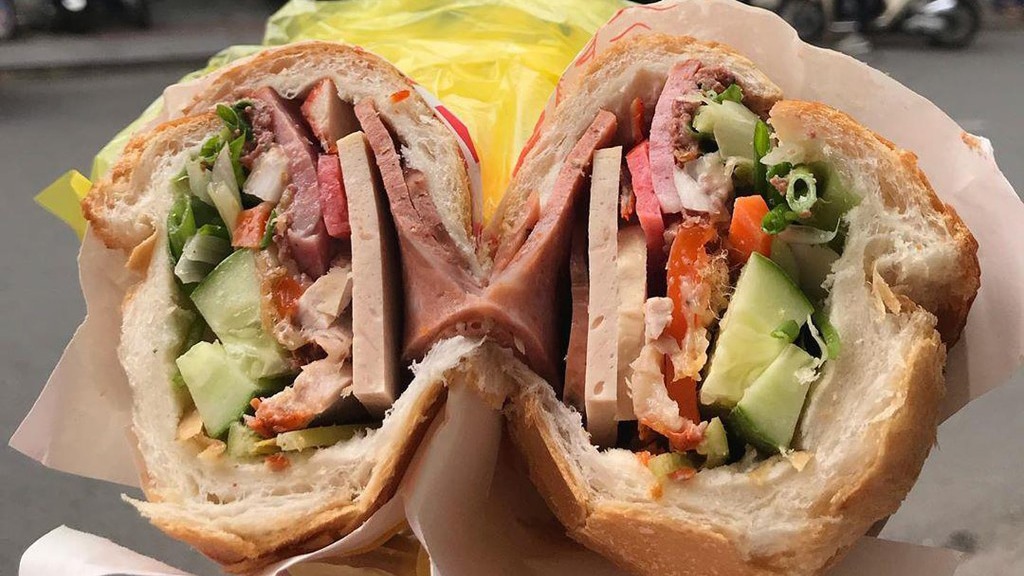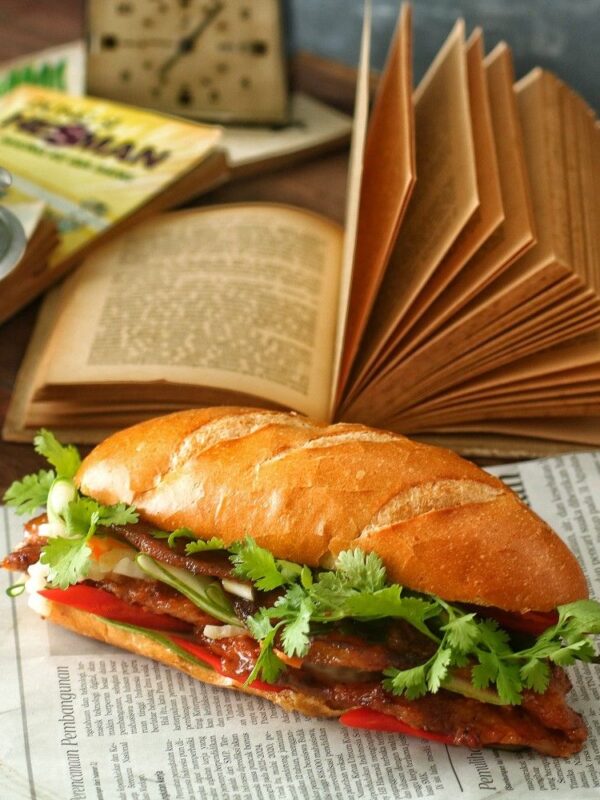Recently updated on November 4th, 2022 at 08:12 am
Originally a dish of Western origin, the ceaseless essence, and creativity in popular Vietnamese bread have made it identified and strongly marked on the world culinary map.

Vietnamese bread (also known as “bánh mì”) is a type of Vietnamese street food consisting of a crust of toast with crispy skin and soft intestines; Inside is the filling.
Depending on the taste of the region or personal preferences, people will create different types of bánh mì; usually filled with sausages, meat, fish, vegetarian food, or fruit jam … together with some other auxiliary ingredients; such as pâté, butter, vegetables, chili, pickles ….
History of Vietnamese bread
At the beginning of the 19th century, the French brought the baguette to Gia Dinh (Saigon) to satisfy their culinary delights. In order to create many delicious and hot loaves of bread to serve the needs of the upper class; they built the first brick bakery in Vietnam.
This French bread quickly became popular. That was when the Saigon people processed the baguette into typical Vietnamese bread; with a length of only about 30-40 cm.
The closed structure, allowing the steam of these Indochinese furnaces to be retained; makes the baguettes become more hollow, the inner cotton is spongy while the outer shell is crispy.
This is also the characteristic that creates the unique identity of Vietnamese bread compared to Western bread.
But Vietnamese bánh mì was only really shaped when the Hoa Ma shop of Mr. Hoa and Mrs. Tinh appeared in 1958.
Because Mrs. Tinh used to work for a ham company specializing in supplying products to French restaurants. in Hanoi; So when they entered Saigon, they opened a shop selling sandwiches and ham to serve local people.
Initially, the shop also serves Western-style sandwiches with cold meats on the plate and will serve with knives and forks. But then seeing that not everyone had time to sit and relax to eat, the owners of Hoa Ma bakery came up with a way of sandwiching meat, pork rolls, and pate in the middle of a loaf of bread for buyers to carry.
Students and civil servants love this way of Hoa Ma shop. Sometime later, many bánh mì shops began to appear in Saigon and are maintained to this day; Which are Bay Ho bread, and Hoang Hoa bread … along with thousands of stalls, carrying seaweed with all kinds of meat, canned fish, …
Different versions of Vietnamese bread across Vietnam
Over time, bread has been present in all areas, Vietnameseized to satisfy a variety of diners. The inside of the cake is getting thinner and thinner, the crust is thicker; the bread size is also 2-3 times smaller for convenience of carrying.
Not only that, but it also became the “national” fast food for everyone because of its diversity and convenience; and most importantly, the price is very cheap.
There is no need for customers to park their car in the shop, sometimes even without a seat; just pull over to the side of the road with one foot on the ground; wait 5 or 10 minutes to buy some delicious bánh mì to bring.
The fast, neat, maneuverable and easy-going breadth of bánh mì is hard to match with any other fast food brand in the world.
Try remembering how you felt when you first tasted bread. As soon as you reach the first bite, you are sure not only to enjoy the crunchy crust but also to be absorbed in the throbbing sound of crumbling in your mouth.
Then came the soft crust of bread like a cotton cushion inside, which was tightening because it was soaked with butter and gravy, and rich sauce.
Vietnamese bánh mì is an explosion of flavors and textures; Salty, sweet, sour, spicy, crunchy, chewy, soft, an incredible fusion of earthly flavors.
On this S-strip, bread can be found in any city, any street; from ordinary working, quarters to busy commercial centers; from sidewalks, and sidewalks to luxury hotels.
Interestingly, you can meet different versions, and taste many different flavors – corresponding to the culinary characteristics of each city and region.
In Hanoi
Bánh mì in Hanoi, for example, seems simpler than many other places. You will hardly find a big bread full of meat and vegetables with so many ingredients in Hanoi; simply because people don’t like to eat like that!

Traditional bánh mì Hanoi includes only a little fragrant butter, liver pate, extra pork, ham, grilled meat, a few slices of sausage, and sliced pork rolls.
Vegetables are served usually only coriander, and cucumber, the sauce used will be traditional chili sauce tearing the tongue.
But the traditional bánh mì Hanoi is still surprisingly delicious; because its crunch perfectly matches the taste of meat and spices.
In Hai Phong
Arriving in Hai Phong, you will be fascinated by the version of bánh mì here. The bread that is only about 2 fingers large can still make people fall in love with the generous and fatty pate layer that is sprinkled with “chí chương” (a type of chili sauce of Hai Phong).

The small bread is always baked hot; so when you eat it, you can clearly see the crunchy crust, and the soft, spicy of kernel is extremely catchy. That’s why when people eat sandwiches, people often order a dozen to eat.
and Hoian
In Hoi An, where there are bread stalls that make international chefs have to rub; bánh mì has its own unique variations. The bread was about the size of an adult’s hand half an adult’s hand, crunchy, thick, and fragrant.

Most especially, the filling of bánh mì Hoi An is extremely diverse; only the inner filling is also up to ten types; including ham, sausages, pork rolls, bacon, grilled meat, chicken, eggs, cheese …
Not to mention the types of butter and sauces prepared according to their own recipe and the herbs of Tra Que village; which make people enjoy eating one just want to eat two.
and Saigon…
The experience of eating bánh mì in the South is different. Due to the favorable natural conditions, bánh mì in the South is often added with a lot of vegetables; such as A few slices of cucumber, white radish, carrot, pickled carrots; add a few stalks of onions, cilantro, and a few slices of chili.

Not only is meat bread with pickles and vegetables, but Saigonese has many more variations on the filling; omelet bread, minced pork meatball bread, and roasted pork sandwiches, …
The characteristic of bánh mì Saigon is probably the taste of openness like the diversity of the bread, the enthusiasm like a crunchy crust, and all kinds of sauces soaked without fear that the bread will be less delicious.
But not only is the bread in the store worth the taste, but even the street-side bread stalls or the street vendors can make delicious, sobbing bread.
Just a glass cabinet displaying the ingredients, a coal oven to keep the bread always crispy, a frying stove with fish balls, fried eggs … and of course a skillful seller; So get ready for a delicious loaf of bread.
Vietnamese bread in other parts of the world
Also listed in the dictionary, as famous as pho, but the path to Vietnamese bread popularity is probably a spiral. It is a journey of a “foreign” dish re-created by Vietnamese in unique ways right in Vietnam; After that, it followed Vietnamese people around the world; and became one of the symbols of Vietnamese street food in the eyes of world friends.
The times bánh mì Vietnam is honored and promoted by major international culinary and media experts; such as The Guardian, BBC, and chef Anthony Bourdain … praise is not rare. After all, the perfect match between Western cuisine and the essence of Vietnamese cuisine; bánh mì is very close to the liberal sandwich culture of the West but is very sophisticated, delicate, and mysterious in East Asia; so it is still famous in separate ways.
Today, everywhere with large Vietnamese communities, you will find at least one bakery; like Boys Banh Mi in Toronto, Thi Thi Bread in Calgary in Canada, or Banh Mi Ba and Mr. Bread in Prague, Czech Republic.
In Malaysia, there is a brand of bread called O Banh Mi and it is really a “big bang” to become a favorite place of indigenous people. In Thailand, there are mobile bread vending machines all over the city; and it has become the most popular and sought-after name.
In the US, where there are many Vietnamese people, there are even many famous bread shops; such as Saigon Bread in New York, Bun Mee in San Francisco; and the famous Lee’s Sandwiches chain that stretches across the South.
Even Yum Brands; which owns KFC and Pizza Hut; also opened a bakery in Texas and gave it a dear name Banh Shop…
Vietnamese bread today
And when people thought there was nothing more to be created about this famous international dish that has been continuously created for 150 years, Vietnamese people still keep coming up with feverish versions. The latest one must mention the dragon fruit bread version.
From the bread made to rescue dragon fruit during the epidemic season, this bread was so successful that it caused the Vietnamese to line up waiting to buy it; The world is eager and online, and people are racing to tinker with the recipe to make a fragrant pink bread.
Over 150 years of appearing in Vietnam, whether old or new, bread variations have never disappointed culinary enthusiasts. Above all, these inventions also show how many Vietnamese people love bread, and how open it can be.

